 How many dresses are too many to take to a wedding?
How many dresses are too many to take to a wedding?
If one is the Mother of the Bride, there is no limit.
If one sews, the limit is only established by the time available for sewing. Using Tried and True Patterns helped with the limited time availability.
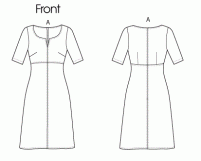
Vogue 8764
From left to right:
- Long Dress: Vogue 8764
- Beach Cover Up
- Short Dress: Vogue 8764
- Linen and Lace Dress: Butterick 6953
- Mother of the Bride Dress: McCalls 6953
- Yellow Dress
- Rehearsal Dinner Dress: Vogue 8764
- Silk Tunic Dress: Vogue 9062
- Floral Linen Dress: Vogue 9062
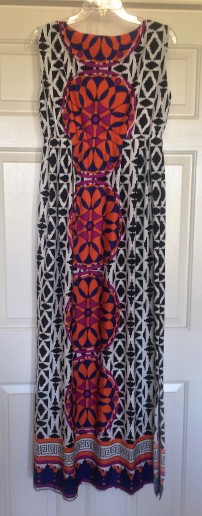
Long Dress – Back View
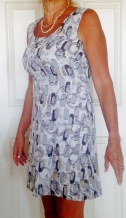
Jetson’s Dress
Vogue 8764 became a “Go To” pattern not long after it was used to sew the muslin “Jetson’s Dress.
It has a raised front waist that angles down slightly toward the back. The simple lines of the pattern allow for easy modification.
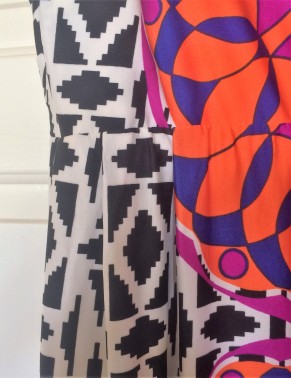
Pleats added at waist seam
The Long and Short Dresses (1 and 3 in the above photo) were sewn with knit fabrics. To accommodate the graphic pattern, the skirts were cut straight. Pleats were added at the waistline seam as gathers would have been bulky – and distroted the graphic pattern.
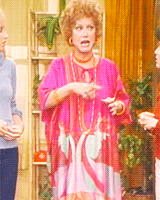 The necklines were rounded and the notch was eliminated. The bodice was lined with a plain white knit. The stretch of the knit fabric eliminated the need for the center back zipper.
The necklines were rounded and the notch was eliminated. The bodice was lined with a plain white knit. The stretch of the knit fabric eliminated the need for the center back zipper.
After the dresses were completed, I noticed the weight of the fabric pulled the bodice down and away from the body. To counter the resulting unflattering fit (think caftan – Mrs. Roper for those that remember Three’s Company), 3/4″ elastic was sewn to the seam allowance of the waist seam. The elastic successfully returned the waistline seam to it empire waist location and provided shape to the dresses. Sorry, Mrs. Roper.
 Vogue 8764 was also used for the Rehearsal Dinner Dress. Several modifications were made to reflect a 1960’s pattern. (Lesson learned: Patterns from 1960 do not fit even close to current patterns.)
Vogue 8764 was also used for the Rehearsal Dinner Dress. Several modifications were made to reflect a 1960’s pattern. (Lesson learned: Patterns from 1960 do not fit even close to current patterns.)
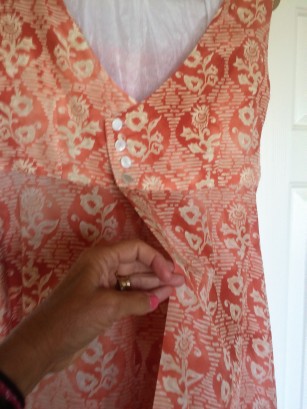 The bodice back was modified for the deep V and button closure. The back skirt was doubled and pleated. The skirt was seamed closed on one side to ensure those wonderful Caribbean breezes did not blow the back opened!
The bodice back was modified for the deep V and button closure. The back skirt was doubled and pleated. The skirt was seamed closed on one side to ensure those wonderful Caribbean breezes did not blow the back opened!
The fabric is a beautiful silk from my mother’s Stash. Her husband bought it for her in Asia. The piece was over 4 yards in length. The bodice was self-lined.
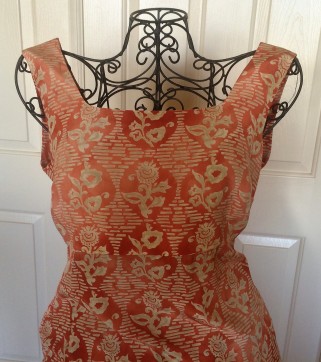 The neckline was squared to reflect the 1960’s pattern neckline. The length of the dress hits just below the knee – the perfect length for a even gathering at the beach!
The neckline was squared to reflect the 1960’s pattern neckline. The length of the dress hits just below the knee – the perfect length for a even gathering at the beach!
The silk was wonderful to sew with and wonderful to wear in the heat and humidity. My mother gifted me several pieces of similar silks. The blue/grey Silk Tunic Dress (Number 8 in the above photo) was sewn from a yard length piece.
More on the other Mother of the Bride traveling wardrobe soon (I have to find the pattern for the Yellow Dress and the Beach Cover Up!)





When you use a knit rather than woven fabric for which pattern is drafted, how do you adjust to compensate for the need of less ease?
Oh! Good question.
I typically cut the pattern one size smaller when sewing with knits.
If the knit is only stretch in one direction (typically width), then I only cut it one size smaller in circumference. If the knit is stretch in both directions (as this knit was), then I cut it one size smaller in both height and circumference.
Knit or woven, additional adjustments are usually required once the bodice has been sewn.
Thanks for asking! Hope this helps.
Very impressive how you guys can design clothes. Thats looks frustrating difficult lol